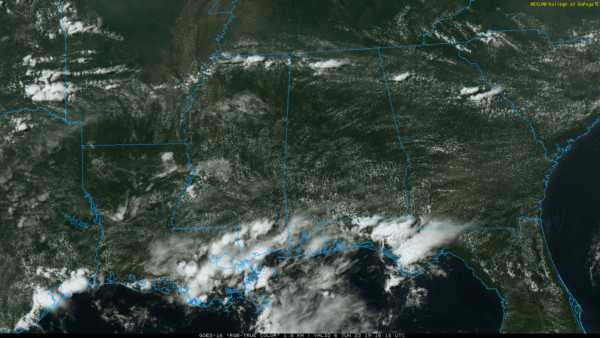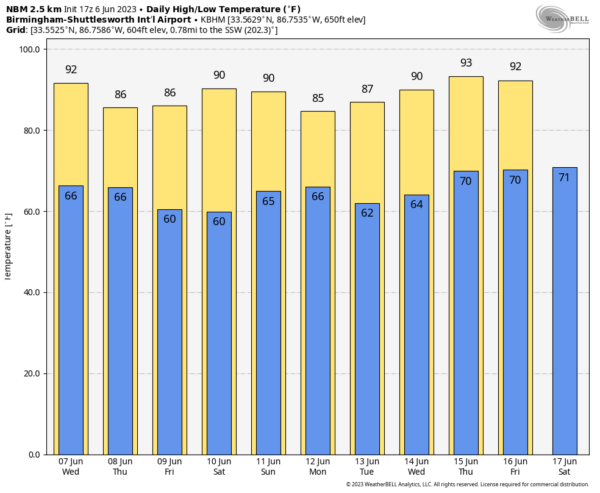A Few Isolated Storms Through Thursday; Dry Air Arrives Friday
RADAR CHECK: A few isolated showers and storms are in progress across parts of the Tennessee Valley of North Alabama, and also near the Gulf Coast at mid-afternoon. The rest of Alabama is dry with a mostly sunny sky… temperatures are in the 86-91 degree range. Isolated showers will end this evening, and tonight will be mostly fair with a low in the 60s.
The weather won’t change much tomorrow; just a few isolated afternoon showers around with a high close to 90. A surface front drops into the state Thursday with some risk of scattered showers or storms; temperatures will be lower with a high in the mid 80s.
FRIDAY AND THE WEEKEND: An unusually dry airmass for summer will drop into Alabama Friday and Saturday. We expect sunshine in full supply both days with lower humidity and cooler nights. Highs will drop into the mid 80s, and many spots will see early morning lows in the 50s. Then, on Sunday, moisture levels rise and we will bring back the chance of scattered, mostly afternoon and evening showers and thunderstorms. Sunday’s high will be close to 90 degrees.
NEXT WEEK: At this point it looks like we will experience typical summer weather through the week with partly sunny days and the risk of random, scattered storms during the peak of the daytime heating process. Heat levels will rise, and we could see mid 90s over the latter half of the week. See the video briefing for maps, graphics, and more details.
TROPICS: A non-tropical area of low pressure located near the eastern Azores is producing disorganized showers and thunderstorms with winds to gale force over the northeastern Atlantic Ocean. This system could acquire some subtropical characteristics during the next day or so while it meanders to the east of the Azores. By late Wednesday, the system is forecast to move northeastward over cooler waters, and further development is not expected. Regardless of development, heavy rains and gusty winds will continue across portions of the Canary Islands, Madeira Island, and the Azores over the next day or so.
No tropical systems are expected anywhere near the U.S. through early next week.
ON THIS DATE IN 1816: The temperature reached 92 degrees at Salem, Massachusetts during an early heat wave, but then plunged 49 degrees in 24 hours to commence the famous “year without a summer.” Snow fell near Quebec City, Quebec Canada from the 6th through the 10th and accumulated up to a foot with “drifts reaching the axle trees of carriages.”
Evidence suggests that the anomaly was predominantly a volcanic winter event caused by the massive 1815 eruption of Mount Tambora in April in the Dutch East Indies (known today as Indonesia). This eruption was the largest in at least 1,300 years (after the hypothesized eruption causing the volcanic winter of 536); its effect in the climate may have been exacerbated by the 1814 eruption of Mayon in the Philippines.
ON THIS DATE IN 1944: Allied forces landed in northern France as part of a military action that paved the way for the defeat of Nazi Germany, molding the course of world history. Perhaps the most important weather forecast ever made was the one for D-Day.
On the evening of June 4, Captain James Martin Stagg, the highest ranking of the support meteorologists, convinced General Dwight D. Eisenhower to postpone the invasion by 24-hours. It was a decision that would prove crucial as the forecast ended up panning out. The weather on June 5 brought rough seas and 25-30 mph winds in the English Channel, but on June 6 the weather featured relatively clear skies and calm seas, which were necessary in order to make the invasion a successful one.
Look for the next video briefing here by 6:00 a.m. tomorrow…
Category: Alabama's Weather, ALL POSTS, Weather Xtreme Videos



















